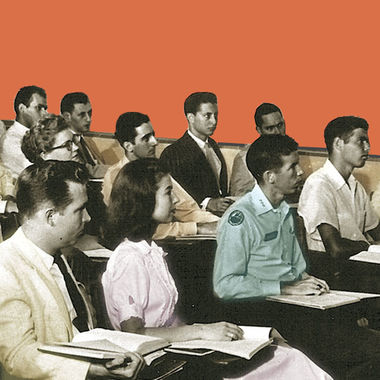Tue Nov 13 2018 · 6 min read
The Challenges of National Educational Assessments in Armenia

By Hayk Daveyan

All types and models of educational assessment have a fundamental mission - to measure and document what students have learned and to secure substantial and reliable feedback for professionals involved at different levels (e.g. decision makers, policy makers, researchers, teachers) in the education system.
Depending on the problem and need, the goal of assessments and testing are adjusted. For example, assessments for university acceptance compare applicants to one another, whereas the goal of a national assessment system is to clarify what kind of proficiency has been accumulated at the national level and the context in which it has developed.
However, whatever the goal is, the essence of educational assessments remain the same.
The implementation of national assessment systems is directly linked to the goal of securing economic growth and poverty reduction. Why? Because this fundamentally changes the emphasis of assessments from simply gathering and registering raw data to determining learning outcomes; that is knowledge and skills acquired during the general education. This emphasis is important from the viewpoint of the development of human capital because in contemporary society, knowledge and skills are replacing raw material and labor forces.
In order for a country to properly manage and guide the education system and the knowledge and skills developed thereof, it needs credible and reliable information/data about itself, it must recognize itself. With this objective in mind, the application of standardized testing tools must be directed not only toward the individual, but be an assessment of educational achievements of the entire population. In addition to evaluating the achievements of the educational system, it will also allow the consideration of factors associated with the level of achievement. In other words, it will allow for the evaluation of the educational context
Educational Assessment in Armenia
The Republic of Armenia acquired practical experience in using large-scale assessment tools starting in 2003, when it first took part in the Trends in International Mathematics and Science Study (TIMSS), an international comparative assessment program. This assessment was established by the International Association for the Evaluation of Educational Achievement (IEA) and is applied once every four years and Armenia has taken part in all assessments since 2003 (2007, 2011 and 2015). TIMSS is organized at the national level and being an international comparative assessment of student achievement in mathematics and science, it is conducted through a representative sampling framework from all regions; around 150 schools, more than 5000 4th and 8th grade students, their parents, principles of the schools and teachers. This immense information base is openly available on TIMSS’ official website. Despite the importance of the review that enables participating countries to make evidence-based decisions for improving educational policy, Armenia does not integrate the results of the study into its own educational policies. In fact, neither the national assessments nor international assessments are conducted properly. Capacity development is critical in designing test items and questionnaires, sampling and data analysis. Ultimately, with proper analyses, the results of the testing could and should be used for curriculum development and educational policy making.
TIMSS and other similar assessment programs (PISA, PIRLS) implemented in different countries are an invaluable resource for professionals who wish to evaluate the results of their country in a comparative international context. They are of less interest to professionals who need to come to conclusions on a national level and are mandated to solve tactical issues. Why? Despite being multidimensional and employing valid tools, international assessments often might not take into consideration the unique circumstances or cultural characteristics of a given educational system. This is explained by the international comparative setup of the program that tends to standardize to the greatest possible extent. For us to have an overview that corresponds to the specifics of the educational system of our country and can cater to our specific goals, we need to design our own system of assessment of educational achievement.
Modest attempts to create national educational assessment on achievements have been implemented in Armenia, but they have not been successful for a number of reasons, which we will discuss below.
1. Quality of Test Items
The task of developing test items and assignments for a large-scale testing system was discussed in Armenia for the first time in 2004, when the National Center for Assessment and Testing (ATC) was created. The center was mandated with organizing and implementing university entrance examinations. For this reason, ATC created tests that evaluate the applicant’s ability to memorize by heart - a mentality derived from the logic of the Soviet educational system. Comparably more difficult questions continued to be dependant upon the knowledge of facts rather than an applicant’s ability to judge or draw conclusions. By inertia or force of tradition, exercises that are based on facts or “knowing” are also included in the National Assessment System (in Armenia, they are called National Review of Natural Science Subjects and National Review of Armenian Studies). Let us tentatively call this approach knowledge-based.
Another approach in the development of testing can be conditionally called life skills-based or competency-based exercises. From these exercises, conclusions can be drawn about the capabilities of those taking the tests. A fact-based national educational assessment attempt cannot serve as the basis to evaluate the level of educational achievement in the country.
On the other hand, there is no doubt that creating a quality testing system is a very difficult task, and all countries (working to develop their own systems) face similar challenges. To guarantee the quality of the tests, the country needs serious human capital, people who are actually able to develop these tests.
2. Output of Results
National evaluation tests have nonetheless been implemented with the exercises and test items described above. The implementation itself does not mean much. With equal success, four TIMSS evaluations have been carried out in Armenia. What is needed by those implementing this policy, is an appropriate analysis of the results and consistent improvement.
To ensure that the output of results are included in the political agenda, there needs to be clearly formulated and effective feedback mechanisms in place. Such mechanisms, even if they exist in Armenia, are not being implemented to say the least. In the absence of an educational policy culture, lack of political will and reliable studies about education, it has not been possible previously to include these on the country’s political agenda.
Improving the quality of the tests and changing the scope of focus is a relatively easier task to accomplish since the methods and tools are there including international best practices. The greater challenge is to transfer the results into policies.
Under conditions of the current political situation in Armenia, there is fertile ground for improvement of the educational system. The guidelines announced by the decision making structures directly assume the need for a evidence-based policy on education and consequently, a credible assessment of reliable facts. Therefore, the issue of creating a national assessment system or improving the already existing one should be brought to the agenda.
related
Araratian Baccalaureate: Transforming the Future or Creating Selective Education?
By Lusine Sargsyan
The Araratian Baccalaureate, a public-private partnership between the Armenian Government and Ayb Education Foundation launched under the previous administration, came under the spotlight when Education Minister Arayik Harutyunyan questioned the need for “elite” schools and the financial efficacy of the program.
How to Transform High-Tech Education in Armenia
By Artashes Vardanyan
Education has the immense power to impact industries and the economy. Artashes Vardanyan writes about the need to transform the educational system to meet the needs of one particularly promising sector of Armenia's economy, the High-Tech industry.
Independence Generation: Education, Societal Aspirations and Implications for Development
By Narek Manukyan
This commentary by Narek Manukyan touches upon some of the key findings about education in a study commissioned by the Friedrich-Ebert-Stiftung called, "Independence Generation - Youth Study 2016." It takes an in-depth look at societal aspirations and how they impact youth within the context of education.
Serving the underserved in education was a vision brought to life by Larisa Hovannisian, the Founder and CEO of Teach for Armenia. EVN Report's Maria Titizian sat down with Larisa to talk about the challenges facing Armenia's education system, the goals and objectives of Teach for Armenia and the impact her organization's work is having in the regions of the country.
Vahram Soghomonyan, member of the Civic Educational Initiative, shares his insight into the crisis of the educational system in Armenia- from considerable cuts to the budget, to state discrimination between kindergartens in Yerevan and the regions, to the presence of the concept of Army Nation in the system – and the implications all these will have for the future of Armenia.






